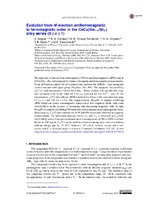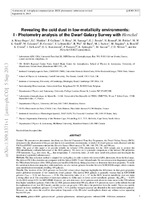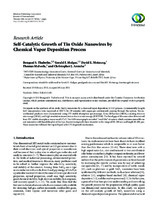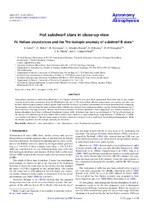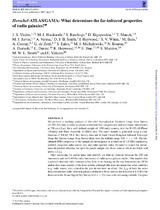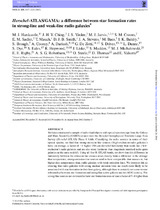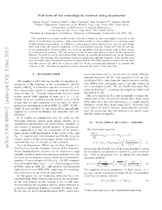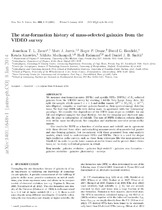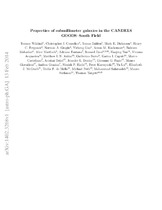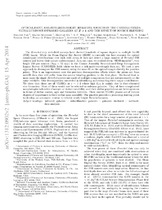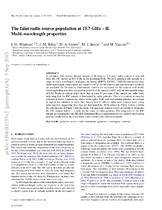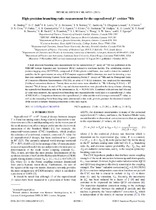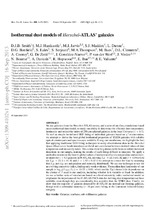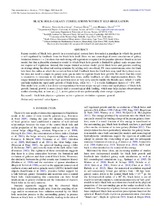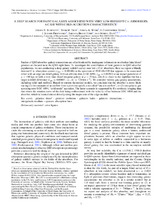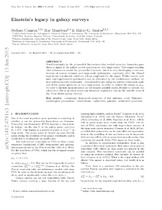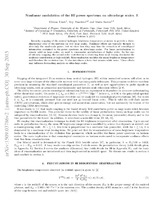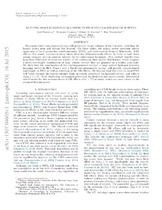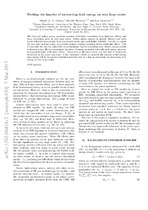Research Articles (Physics): Recent submissions
Now showing items 501-520 of 520
-
Evolution from 4f-electron antiferromagnetic to ferromagnetic order in the CeCu(Ge1-xSnx) alloy series (0≤x≤1)
(American Institute of Physics Inc., 2017)We report the evolution from ferromagnetic (FM) to antiferromagnetic (AFM) state in CeCu(Ge1-xSnx) investigated by means of magnetic and heat capacity measurements. X-ray diffraction studies for all compositions indicate ... -
Revealing the cold dust in low-metallicity environments: I. Photometry analysis of the Dwarf Galaxy Survey with Herschel
(EDP Sciences, 2013)Context. We present new photometric data from our Herschel Guaranteed Time Key Programme, the Dwarf Galaxy Survey (DGS), dedicated to the observation of the gas and dust in low-metallicity environments. A total of 48 ... -
Existence domains of dust-acoustic solitons and supersolitons
(AIP PublishingAIP Publishing, 2013)Using the Sagdeev potential method, the existence of large amplitude dust-acoustic solitons and supersolitons is investigated in a plasma comprising cold negative dust, adiabatic positive dust, Boltzmann electrons, and ... -
Self-catalytic growth of tin oxide nanowires by chemical vapor deposition process
(Hindawi, 2013)We report on the synthesis of tin oxide (SnO2) nanowires by a chemical vapor deposition (CVD) process. Commercially bought SnO nanopowders were vaporized at 1050∘C for 30 minutes with argon gas continuously passing through ... -
Hot subdwarf stars in close-up view IV. Helium abundances and the 3He isotopic anomaly of subdwarf B stars
(EDP Sciences, 2013)Atmospheric parameters and helium abundances of 44 bright subdwarf B stars have been determined. More than half of our sample consists of newly discovered stars from the Edinburgh Cape survey. We showed that effective ... -
Herschel-ATLAS/GAMA: What determines the far-infrared properties of radio galaxies?
(OUP, 2013)We perform a stacking analysis of Herschel Astrophysical Terahertz Large Area Survey (H-ATLAS) data in order to obtain isothermal dust temperatures and rest-frame luminosities at 250 µm (L250), for a well-defined sample ... -
Herschel-atlas/Gama: a difference between star formation rates in strong-line and weak-line radio galaxies
(OUP, 2013)We have constructed a sample of radio-loud objects with optical spectroscopy from the Galaxy and Mass Assembly (GAMA) project over the Herschel Astrophysical Terahertz Large Area Survey (Herschel-ATLAS) Phase 1 fields. ... -
Null tests of the cosmological constant using supernovae
(American Physical Society, 2014)The standard concordance model of the Universe is based on the cosmological constant as the driver of accelerating expansion. This concordance model is being subjected to a growing range of inter-locking observations. ... -
The star-formation history of mass-selected galaxies from the VIDEO survey
(Oxford University Press, 2014)We measure star formation rates (SFRs) and specific SFRs (SSFRs) of Ks-selected galaxies from the VISTA Deep Extragalactic Observations survey by stacking 1.4 GHz Very Large Array data. We split the sample, which spans 0 ... -
Properties of submillimeter galaxies in the CANDELS GOODS-south field
(American Physical Society, 2014)We derive physical properties of 10 submillimeter galaxies located in the CANDELS coverage of the GOODS-S field. The galaxies were first identified as submillimeter sources with the LABOCA bolometer and subsequently targeted ... -
Optical-faint, far-infrared-bright Herschel sources in the CANDELS fields: Ultra-luminous infrared galaxies at z > 1 and the effect of source blending
(American Astronomical Society, 2014)The Herschel very wide-field surveys have charted hundreds of square degrees in multiple far-IR (FIR) bands. While the Sloan Digital Sky Survey (SDSS) is currently the best resource for optical counterpart identifications ... -
The faint radio source population at 15.7 GHz - II. Multi-wavelength properties
(Oxford University Press, 2015)A complete, flux density limited sample of 96 faint (> 0:5 mJy) radio sources is selected from the 10C survey at 15.7 GHz in the Lockman Hole. We have matched this sample to a range of multi-wavelength catalogues, including ... -
High-Precision Branching Ratio Measurement for the Superallowed + Emitter 74Rb
(American Physical Society, 2013)A high-precision branching-ratio measurement for the superallowed β + decay of 74Rb was performed at the TRIUMF Isotope Separator and Accelerator (ISAC) radioactive ion-beam facility. The scintillating electronpositron tagging ... -
Isothermal dust models of Herschel-ATLAS galaxies
(Oxford University Press, 2013)We use galaxies from the Herschel-ATLAS survey, and a suite of ancillary simulations based on an isothermal dust model, to study our ability to determine the effective dust temperature, luminosity and emissivity index of ... -
Black hole - galaxy correlations without self-regulation
(American Astronomical Society, 2013)Recent models of black hole growth in a cosmological context have forwarded a paradigm in which the growth is self-regulated by feedback from the black hole itself. Here we use cosmological zoom simulations of galaxy formation ... -
A deep search for faint galaxies associated with very low-redshift C iv absorbers: A case with cold-accretion characteristics
(The American Astronomical Society, 2013)Studies of QSO absorber–galaxy connections are often hindered by inadequate information on whether faint/dwarf galaxies are located near the QSO sight lines. To investigate the contribution of faint galaxies to QSO ... -
Einstein's legacy in galaxy surveys
(Oxford University Press, 2015)Non-Gaussianity in the primordial fluctuations that seeded structure formation produces a signal in the galaxy power spectrum on very large scales. This signal contains vital information about the primordial Universe, but ... -
Nonlinear modulation of the HI power spectrum on ultra-large scales. I
(IOP Science, 2015)Intensity mapping of the neutral hydrogen brightness temperature promises to provide a three-dimensional view of the universe on very large scales. Nonlinear effects are typically thought to alter only the small-scale ... -
Hunting down horizon-scale effects with multi-wavelength surveys
(American Astronomical Society, 2015)Next-generation cosmological surveys will probe ever larger volumes of the universe, including the largest scales, near and beyond the horizon. On these scales, the galaxy power spectrum carries signatures of local primordial ... -
Probing the imprint of interacting dark energy on very large scales
(American Physical Society, 2015)The observed galaxy power spectrum acquires relativistic corrections from light-cone effects, and these corrections grow on very large scales. Future galaxy surveys in optical, infrared and radio bands will probe increasingly ...

